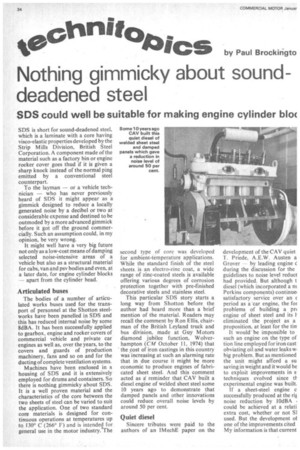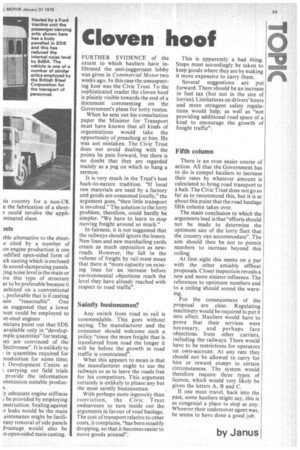t e ei nito ,
Page 38

Page 39

If you've noticed an error in this article please click here to report it so we can fix it.
Nothing gimmicky about sound deadened steel
SDS could well be suitable for making engine cylinder blo(
SDS is short for sound-deadened steel, which is a laminate with a core having visco-elastic properties developed by the Strip Mills Division, British Steel Corporation. A component made of the material such as a factory bin or engine rocker cover goes thud if it is given a sharp knock instead of the normal ping emitted by a conventional steel counterpart.
To the layman — or a vehicle tech nician who has never previously heard of SOS it might appear as a gimmick designed to reduce a locally generated noise by a decibel or two at considerable expense and destined to be outmoded by a more advanced gimmick before it got off the ground commercially. Such an assumption could, in my opinion, be very wrong.
It might well have a very big future not only as a low-cost means of damping selected noise-intensive areas of a vehicle but also as a structural material for cabs, van and psv bodies and even, at a later date, for engine cylinder blocks — apart from the cylinder head.
Articulated buses
The bodies of a number of articulated works buses used for the transport of personnel at the Shotton steelworks have been panelled in SDS and this has reduced internal noise by some $dBA. It has been successfully applied to gearbox, engine and rocker covers of commercial vehicle and private car engines as well as, over the years, to the covers and guards of production machinery, fans and so on and for the ducting of complete ventilation systems.
Machines have been enclosed in a housing of SDS and it is extensively employed for drums and containers. So there is nothing gimmicky about SDS. It is a well proven material and the characteristics of the core between the two sheets of steel can be varied to suit the application. One of two standard core materials is designed for continuous operations at temperatures up to 130° C (266° F) and is intended for general use in the motor industry. The second type of core was developed for ambient-temperature applications. While the standard finish of the steel sheets is an electro-zinc coat, a wide range of zinc-coated steels is available offering various degrees of corrosion protection together with pre-finished decorative steels and stainless steel.
This particular SDS story starts a long way from Shotton before the author had heard more than a brief mention of the material. Readers may recall the comment by Ron Ellis, chairman of the British Leyland truck and bus division, made at Guy Motors diamond jubilee function, Wolverhampton (CM October 11, 1974) that the cost of iron castings in this country was increasing at such an alarming rate that in due course it might be more economic to produce engines of fabricated sheet steel. And this comment acted as a! reminder that CAV built a diesel engine of welded sheet steel some 10 years ago to demonstrate that damped panels and other innovations could reduce overall noise levels by around 50 per cent.
Quiet diesel
Sincere tributes were paid to the authors of an IM echE paper on the development of the CAV quiet T. Priede, A.E.W. Austen a Grover — by leading engine c during the discussion for the guidelines to noise level red uct had provided. But although t diesel (which incorporated a nt Perkins components) continuo satisfactory service over an t period as a 'car engine, the foi problems of building a pr4 engine of sheet steel and its 1eliminated the project as a proposition, at least for the tin It would ` be impossible to such an engine on the type of tion line employed for iron cast. obviating oil and water leaks v,h big problem. But as mentioned the unit might afford a su saving in weight and it would be to exploit improvements in s techniques evolved since tt. experimental engine was built.
If a sheet-steel engine c successfully produced at the rii noise reduction by 10dBA could be achieved at a relati extra cost, whether or not 51 used. But the development of one of the improvements cited My information is that current tble alternative to the sheet.e cited by a number of on engine production is one .odified open-sided form of )ck casting which is enclosed de sound-dampening panels. :ing noise level is the main or ive this type of structure ar to be preferable because it achined on a conventional !, preferable that is if casting Lain "reasonable". One as suggested that a lower )our could be employed to .et-steel engines nicians point out that SDS available only in "developmple quantities" for testing, ley are convinced of the Tectiveness". It is unlikely to in quantities required for )roduction for some time; t Development Centre at ; carrying out field trials provide the information )mmission suitable producs.
y adequate engine stiffness be provided by employing mstruction. Sealing against g. leaks would be the main aintenance might be facilieasy removal of side panels avantage would also be .n open-sided main casting.






























































































